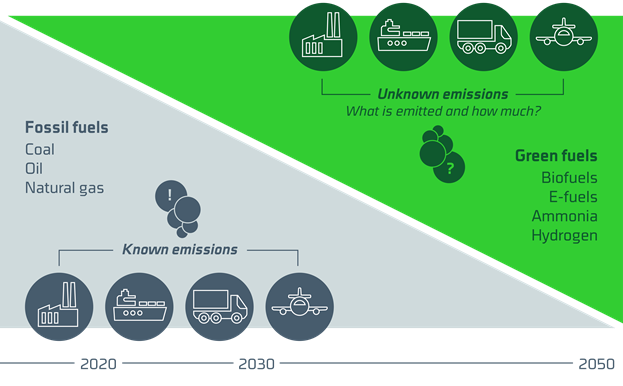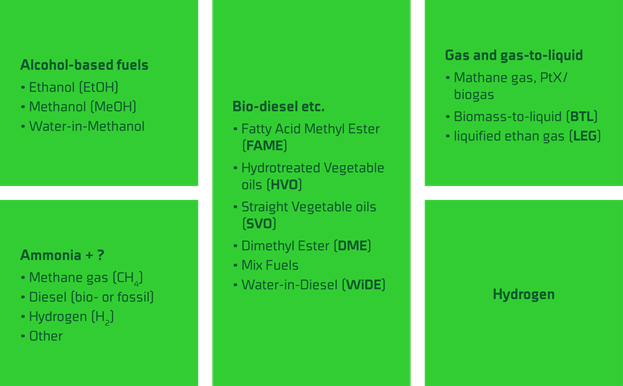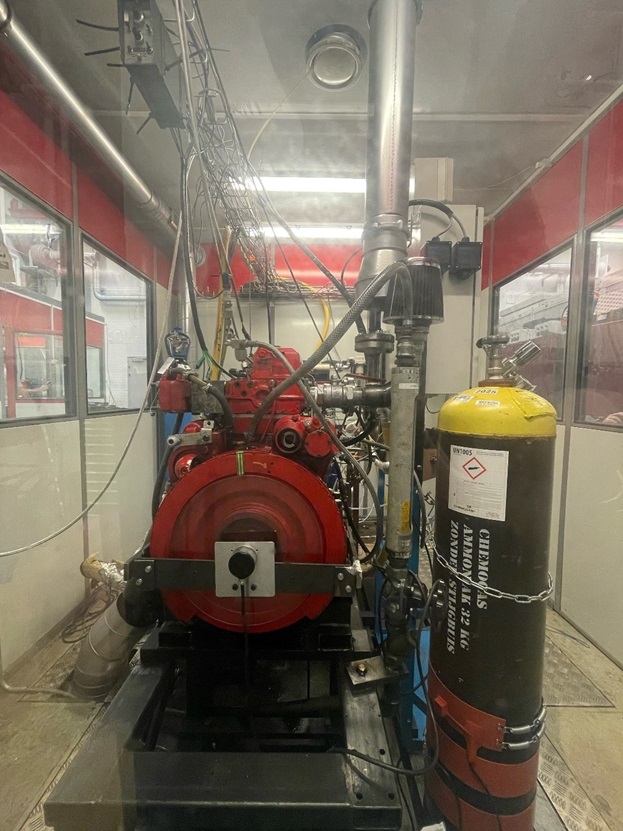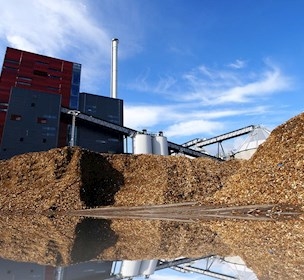Future emissions from new, green fuels for internal combustion engines
Climate targets require us to find newer, greener fuels for internal combustion engines. But what exhaust gases can we expect from these new fuels? Can we eliminate these new emissions?
Health and the climate at the top of the agenda in the green transition
To ensure that temperatures do not rise beyond the targets set, we need to make significant changes to our energy sources for the future. CO2 is the main greenhouse gas, and the introduction of CO2-free energy sources is a key objective in the green transformation.
Environmental health is also an important factor in the green transformation, and the use of new, green fuels can reduce emissions of particulate matter (PM) and sulphur compounds to adhere to the WHO's recommended limits [2].
Most of the energy used in the world for transportation and industry comes from fossil sources, such as oil, gas, and coal. In 2018, the share of fossil fuels in transportation and industry was estimated to be 90% and 75% of total energy consumption, respectively [1].
To increase the proportion of climate-neutral fuels, it is essential to scale up production capacity significantly in the coming years while keeping prices for green fuels low.

New types of green fuels for internal combustion engines
The gamut of green fuels that can be used in internal combustion engines is very broad; see Figure 2. In transportation, fuels such as ethanol and biodiesel are already being phased in on a limited basis.
Other green fuels are in testing. These fuels are still in need of a production and distribution chain to be able to break into the market. New safety and certification requirements will also be crucial as new fuels are phased in in the coming years.
New types of fuels must be adapted to the needs of individual industries. For example, ammonia is expected to be used primarily for internal combustion engines in the maritime sector. The same goes for fuels mixed with water. HVO (hydro-treated vegetable oils), on the other hand, are an example of a biodiesel intended more for road vehicles.

Methanol has also received significant attention in recent years. Methanol can be used not only in petrol engines, but also in compression ignition engines. However, the use of methanol for combustion typically requires the use of a support fuel (dual-fuel principle) such as (bio)diesel, hydrogen, or a similar fuel.
Examples of changing emission patterns with new, green fuels
New types of fuels will lead to changing emission patterns and parameters. For example, the use of methanol can lead to increased emissions of formaldehyde and other hydrocarbons under suboptimal combustion conditions.
Emissions from ammonia combustion are likely to contain higher quantities of nitrous oxide (N2O), NOX, and unburned ammonia. Here, N2O is the primary concern; it is a greenhouse gas that is about 300 times stronger than CO2. In addition, the water content of the exhaust from ammonia combustion will be significantly higher than that emitted by boilers or diesel engines using traditional fossil fuels. While this would not pose health problems, it would place increased demands on the design of the engine and exhaust post-treatment systems. On the other hand, we can expect reductions in sulphur and PM emissions.
Blends of biodiesel and conventional diesel have been used for some time; for instance, B7 diesel, available at most filling stations, contains 7% FAME. An increased share of biodiesel in conventional diesel, or the use of pure biodiesel, will not necessarily lead to a significant reduction in NOX.
Regardless of the fuel used, an internal combustion engine will still need lubrication. Therefore, for all types of green fuels, there will still be a risk of major or minor emissions of particulate matter composed of partially combusted or uncombusted lubricants. This is particularly true for gaseous fuels, such as hydrogen.

Technologies for reducing emissions
A number of technologies are currently in use to reduce emissions from internal combustion engines, including SCR systems, scrubbers, and particulate filters.
Selective catalytic reduction (SCR) systems are used to reduce emissions of NOX and other pollutants. These systems are often used in conjunction with oxidation and ammonia slip catalysts to additionally reduce emissions of unburned hydrocarbons (HC) and ammonia. This ensures that emission requirements are met for land-based vehicles and certain types of marine engines. It is expected that SCR systems, in combination with oxidation and ammonia slip catalysts, will remain key components of the technologies used with the green fuels of the future.
Scrubbers on marine engines that run on fossil fuels such as HFO (heavy fuel oil) reduce emissions of sulphur oxides (SOX). Scrubbers work by passing exhaust gases through a scrubber tower, where an aqueous solution irrigates the gases. Compared to fossil fuels such as HFO, the majority of green fuels contain only small amounts of sulphur; consequently, the need for scrubbers for marine engines is expected to decrease in the future.
Particulate filters are widely used in road traffic contexts to reduce the emission of particulate matter into the environment. The particle filters are made of a porous ceramic material that allows the exhaust to pass through the filter without an excessive pressure drop. The particles are trapped in the filter, which is cleaned or regenerated as needed. In the case of biodiesel in internal combustion engines, particulate filters are expected to remain an important technology.
Project: "Emissions in the green transition”
In January 2021, FORCE Technology launched Emissions in the green transition, a four-year project, with support from the Danish Ministry of Higher Education and Science. The project focuses on emissions from new types of green fuels in transportation and industry.
The aim of this project is to develop services for documenting and reducing emissions from the new, green technologies of the future. The project will support the phasing-in of green fuels and low-environmental-impact technologies. It will accomplish this through the development of methods to predict and document emissions using simulation models and measurements.


